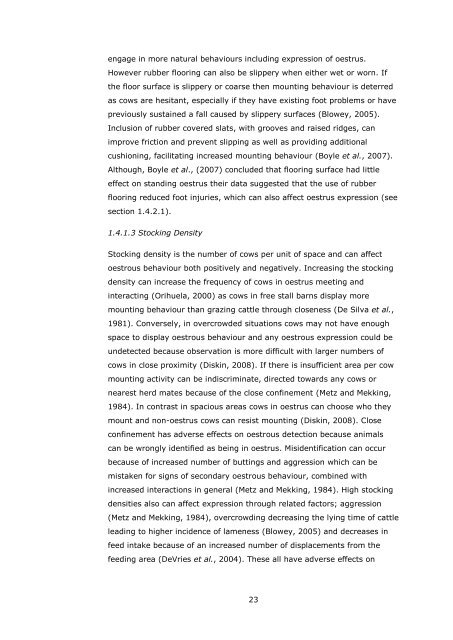novel approaches to expression and detection of oestrus in dairy cows
novel approaches to expression and detection of oestrus in dairy cows
novel approaches to expression and detection of oestrus in dairy cows
Create successful ePaper yourself
Turn your PDF publications into a flip-book with our unique Google optimized e-Paper software.
engage <strong>in</strong> more natural behaviours <strong>in</strong>clud<strong>in</strong>g <strong>expression</strong> <strong>of</strong> <strong>oestrus</strong>.<br />
However rubber floor<strong>in</strong>g can also be slippery when either wet or worn. If<br />
the floor surface is slippery or coarse then mount<strong>in</strong>g behaviour is deterred<br />
as <strong>cows</strong> are hesitant, especially if they have exist<strong>in</strong>g foot problems or have<br />
previously susta<strong>in</strong>ed a fall caused by slippery surfaces (Blowey, 2005).<br />
Inclusion <strong>of</strong> rubber covered slats, with grooves <strong>and</strong> raised ridges, can<br />
improve friction <strong>and</strong> prevent slipp<strong>in</strong>g as well as provid<strong>in</strong>g additional<br />
cushion<strong>in</strong>g, facilitat<strong>in</strong>g <strong>in</strong>creased mount<strong>in</strong>g behaviour (Boyle et al., 2007).<br />
Although, Boyle et al., (2007) concluded that floor<strong>in</strong>g surface had little<br />
effect on st<strong>and</strong><strong>in</strong>g <strong>oestrus</strong> their data suggested that the use <strong>of</strong> rubber<br />
floor<strong>in</strong>g reduced foot <strong>in</strong>juries, which can also affect <strong>oestrus</strong> <strong>expression</strong> (see<br />
section 1.4.2.1).<br />
1.4.1.3 S<strong>to</strong>ck<strong>in</strong>g Density<br />
S<strong>to</strong>ck<strong>in</strong>g density is the number <strong>of</strong> <strong>cows</strong> per unit <strong>of</strong> space <strong>and</strong> can affect<br />
oestrous behaviour both positively <strong>and</strong> negatively. Increas<strong>in</strong>g the s<strong>to</strong>ck<strong>in</strong>g<br />
density can <strong>in</strong>crease the frequency <strong>of</strong> <strong>cows</strong> <strong>in</strong> <strong>oestrus</strong> meet<strong>in</strong>g <strong>and</strong><br />
<strong>in</strong>teract<strong>in</strong>g (Orihuela, 2000) as <strong>cows</strong> <strong>in</strong> free stall barns display more<br />
mount<strong>in</strong>g behaviour than graz<strong>in</strong>g cattle through closeness (De Silva et al.,<br />
1981). Conversely, <strong>in</strong> overcrowded situations <strong>cows</strong> may not have enough<br />
space <strong>to</strong> display oestrous behaviour <strong>and</strong> any oestrous <strong>expression</strong> could be<br />
undetected because observation is more difficult with larger numbers <strong>of</strong><br />
<strong>cows</strong> <strong>in</strong> close proximity (Disk<strong>in</strong>, 2008). If there is <strong>in</strong>sufficient area per cow<br />
mount<strong>in</strong>g activity can be <strong>in</strong>discrim<strong>in</strong>ate, directed <strong>to</strong>wards any <strong>cows</strong> or<br />
nearest herd mates because <strong>of</strong> the close conf<strong>in</strong>ement (Metz <strong>and</strong> Mekk<strong>in</strong>g,<br />
1984). In contrast <strong>in</strong> spacious areas <strong>cows</strong> <strong>in</strong> <strong>oestrus</strong> can choose who they<br />
mount <strong>and</strong> non-<strong>oestrus</strong> <strong>cows</strong> can resist mount<strong>in</strong>g (Disk<strong>in</strong>, 2008). Close<br />
conf<strong>in</strong>ement has adverse effects on oestrous <strong>detection</strong> because animals<br />
can be wrongly identified as be<strong>in</strong>g <strong>in</strong> <strong>oestrus</strong>. Misidentification can occur<br />
because <strong>of</strong> <strong>in</strong>creased number <strong>of</strong> butt<strong>in</strong>gs <strong>and</strong> aggression which can be<br />
mistaken for signs <strong>of</strong> secondary oestrous behaviour, comb<strong>in</strong>ed with<br />
<strong>in</strong>creased <strong>in</strong>teractions <strong>in</strong> general (Metz <strong>and</strong> Mekk<strong>in</strong>g, 1984). High s<strong>to</strong>ck<strong>in</strong>g<br />
densities also can affect <strong>expression</strong> through related fac<strong>to</strong>rs; aggression<br />
(Metz <strong>and</strong> Mekk<strong>in</strong>g, 1984), overcrowd<strong>in</strong>g decreas<strong>in</strong>g the ly<strong>in</strong>g time <strong>of</strong> cattle<br />
lead<strong>in</strong>g <strong>to</strong> higher <strong>in</strong>cidence <strong>of</strong> lameness (Blowey, 2005) <strong>and</strong> decreases <strong>in</strong><br />
feed <strong>in</strong>take because <strong>of</strong> an <strong>in</strong>creased number <strong>of</strong> displacements from the<br />
feed<strong>in</strong>g area (DeVries et al., 2004). These all have adverse effects on<br />
23
















